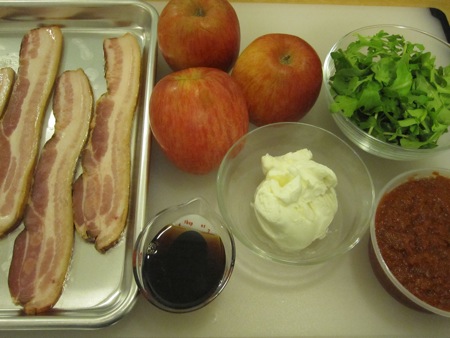I frequently rediscover ideas that have been dormant in the Deep Storage Facility of my long-term memory, triggered by a recent event or conversation. I was thinking about José Andrés’ Harvard lecture on the same day that a birthday present – an iSi canister – arrived, and I remembered that there was something I could make that involved gelatins and foams. I consulted my notes from the Ideas in Food workshop I attended and found a recipe for “aero chocolate,” along with the marginal comment ask them for the recipe. I emailed Alex and Aki, who were kind enough to send me the detailed recipe even though it will appear in their book
any day now.
There aren’t a lot of ingredients, but a few of them are a bit specialized: 400 grams of chocolate (Valrhona Manjari 64% is recommended, I used Valrhona Guanaja 70%), 150 grams of heavy cream, 300 grams of water, 50 grams of glucose syrup, 2 grams of salt, 4 drops of blood orange extract (I could only find blood orange essential oil), 2.4 grams of agar agar, and 0.3 grams of locust bean gum. The measurements in grams make it easier to work out the gelatin (9:1) and salt (0.5%) ratios, but they also require a scale accurate to the hundredth of a gram.
I combined the chocolate, cream, glucose and salt:
While I slowly melted that mixture in the microwave, I whisked the agar agar and locust bean gum into the water and simmered for five minutes.
I poured the melted chocolate mixture into a blender along with the orange oil and the agar agar solution, then blended the mixture to combine.
I poured the chocolate into an iSi canister and charged it with two N2OÂ pods.
I dispensed the aerated mixture into four half-pint mason jars.
After securing the lids to the jars, I placed them in the freezer to chill down quickly. As the hot mixture cools, it creates vacuum pressure inside the jar, which keeps the chocolate aerated.
After a chill in the freezer and then a stay in the fridge, I removed the chocolate from one of the jars, or at least tried to. You might notice the diamond texture on the outside of the jars I used. What I didn’t realize, and failed to check, was that the texture is present on the inside of the jars as well. This made removal of the chocolate in one smooth cylinder an impossibility, but I was able to get most of it out on a solid piece.
To plate (photo at top), I sliced the chocolate into rounds and added a scoop of white plum ice cream drizzled with some mandarin orange syrup. I can’t describe the taste and texture any better than Alex did:
The texture of the aerated chocolate is light and delicate with the first texture of mousse melting into the mouth-feel of pudding.
The blood orange was barely detectable, but I attribute that to using oil instead of a pure extract. Because the “mousse” is gelatin-stabilized, is retains its shape as it warms up, a plus if you choose to pair it with something hot.
What’s that other component on the plate? It’s “instant chocolate cake,” another experiment with foams, and the subject of the next post.
Sources
Chocolate: Whole Foods
Cream: Sherman Market
Glucose syrup: L’Epicerie
Agar agar, locust bean gum: Chef Rubber
Blood orange essential oil: Faerie’s Finest










































